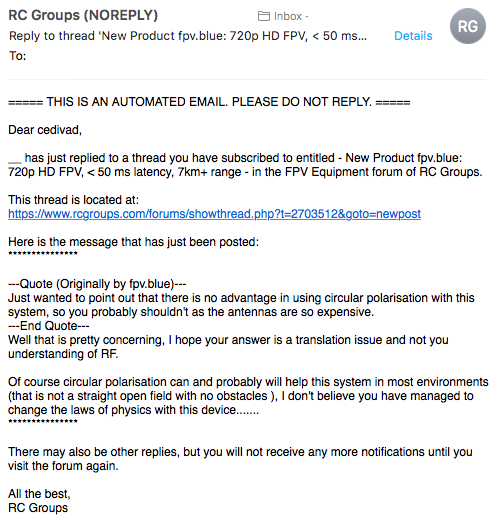Please take a few seconds to read the kind of emails you can get when subscribed to our RCGroups thread:
—Quote (Originally by fpv.blue)—Just wanted to point out that there is no advantage in using circular polarisation with this system, so you probably shouldn’t as the antennas are so expensive.—End Quote—Well that is pretty concerning, I hope your answer is a translation issue and not you understanding of RF.Of course circular polarisation can and probably will help this system in most environments (that is not a straight open field with no obstacles ), I don’t believe you have managed to change the laws of physics with this device…….
Meet the Guard Interval
From Wikipedia:
In OFDM, the beginning of each symbol is preceded by a guard interval. As long as the echoes fall within this interval, they will not affect the receiver’s ability to safely decode the actual data, as data is only interpreted outside the guard interval.
Circular polarisation is popular with analog FPV because of its ability to attenuate reflected signal propagation paths by a few decibels. You don’t want reflected paths in analog FPV as they will be interpreted by the analog receiver at the same time as the actual, non reflected RF signal, reducing the performances of the latter.
However, fpv.blue, being a digital system, can completely reject reflected paths. We have a nice guard interval option in our modulation menu, where you can select the length of this guard interval. If you are flying to another galaxy you might want to use 1/4 as a guard interval (one quarter of the symbol length will not be interpreted and the receiver will sleep waiting for echoes to go away).
Antennas
If you already have expensive circularly polarized antennas that are in good condition, use them! If someone told you you need to purchase expensive antennas to have good performances with this system, link them this blog post.
LCom sells a ~1100 MHz 8 dB patch antenna ($37). This isn’t suited for our frequencies, but RMRC carries a modified version ($47), where they opened the antenna up and trimmed the elements to tune them to 1280 MHz. It should be easy enough to do the mod yourself!
If you really feel crazy about range, you can get a yagi… That you will probably want to use beside a patch as manually pointing yagis is notoriously difficult, so just stick to the patch.


Is this totally true though?
If the received reflected signal is 0dB WRT the straight path signal, would it not scramble the RX packet enough to make the RX system unable to decode it correctly?
So what SNR does your receiver need in order to correctly decode a packet?
Would noise scrap the data packet, or just introduce (possibly correctable) errors like QAM coding?
Interesting project, and not before time..
Trev
Nice question! The required SNR with the default settings is around 5 dB. The point is that the guard interval doesn’t apply for each packet, but for each symbol instead. There is enough time before every single symbol where the demodulator is not listening for any reflected path to attenuate. RCGroups keeps saying that’s impossible, but it’s what is actually happening.
The issue is not so much with reflections, the issue is with cross-polarization where linear can provide up to 20dB of loss at 90-degree angles. It is here were circular provides the biggest benefit for long-range use as even when using one CP antenna, the net loss will never be greater than 3dB whatever the orientation of the antennas, this is a huge benefit.
Correct.
That, plus the fact that linear omni antennas usually have a smaller vertical opening angle which also contributes to a lower signal strength when banking etc.
Is it actually possible to design a linear antenna with a similar radiation pattern as the cloverleafs?
This is very much correct. I didn’t even think of drone racing quads when writing the blog post, I was mostly trying to answer to plane people that were looking for the best antennas to maximise range. I will update the blog post as soon as I have a spare second.
I use circular on my video mainly because I love my Pepperbox. Linear can do just as well, but I love the radiation plot of the Pepperbox. Obviously patch antennas or yagis could do the job as well, but I don’t want a tracker on my setup.